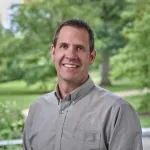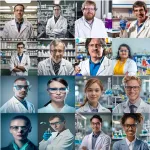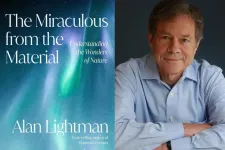(Press-News.org) University of Delaware researchers have developed a method for mitigating the decontamination that tires release into the environment at the end of their lifespan.
In a new study published in Nature Chemical Engineering, the team demonstrated a way to upgrade 6PPD – a molecule that provides UV protection to help the rubber found in tires last longer – into safe chemicals. The method would also turn the leftover crumb rubber into aromatics and carbon black, a soot-like material found in everything from pigments to cosmetics to electronics. The study was led by Dion Vlachos, chair of UD's Department of Chemical and Biomolecular Engineering, and also involved reseachers from the University's Center for Plastics Innovation.
According to Vlachos, tires are responsible for about one-third of the microplastics in the environment. This is because nearly 25% of the components in a tire are made of synthetic rubber, which is a plastic.
Under sun radiation exposure, 6PPD converts to 6PPD-quinone, what is called a diketone, or a molecule made up of two ketone groups. One major source for these diketone molecules is the tires themselves. And it’s not just the microplastics that result from tire wear and tear when in use. These molecules also can be released into the environment from tires left in landfills and exposed to the elements, such as rainfall.
“You can’t put a filter on the environment the way you might have a filter on your household dryer to capture these fibers,” said Vlachos, who also directs the Delaware Energy Institute.
While others in the field have attempted to break tire materials down using high heat, through a process known as pyrolysis, 6PPD is stubborn and the diketone molecules remain in the oil left behind. If the oil is used in fuel or other materials, the diketone molecules go along for the ride, which is a problem.
So, the Vlachos team decided to try and remove the 6PPD through a process known as chemical extraction. This involved placing millimeter-sized pieces of tire, or crumb rubber, into a classic microwave reactor, heating the materials up and using a chemical solvent to quickly separate the 6PPD from the other molecules present.
Once the 6PPD molecules are removed, they can be chemically converted into safe chemicals that can be used or sold for a small price. The rest of the tire, meanwhile, can be recycled using classic plastic recycling methods — a plus, given there currently are no alternatives for tires in general. This would enable remediated tire materials to be used in practical applications, say, on soccer fields, playgrounds or in asphalt for roads, without worry. The crumb rubber also could be used in aromatics, which are starting materials for a wide range of consumer products, or as carbon black, a soot-like material found in many pigments, conductive/insulating elements and reinforcing agents, among other things.
The UD research team has protected the novel approach through the University’s Office of Economic Innovation and Partnerships.
To date, the research team has proven this approach at the lab scale, according to Vlachos, and a technoeconomic analysis showed the cost looks to be very reasonable. It’s a positive step, but more work is needed — and time is of the essence.
Worldwide, the number of end-of-life tires continues to grow, with some reports estimating there could be up to five billion tires in need of disposal worldwide by 2030. Meanwhile, scrap tire use in the United States declined by 25% between 2013 and 2021.
“I think actual recycling of the tire itself is important, so there are truly circular solutions that are doing upcycling,” he said. “We must make things at a large enough scale and at a reasonable cost outside of the laboratory. This has to be demonstrated with pilot-scale facilities. We haven't done that.”
Taking solutions from the lab to the real world will require further engineering effort and time. Having a dedicated Center for Plastics Innovation at UD is a definite advantage, Vlachos said, because it brings a critical mass of people talking, thinking and working on these issues. Startups and other minds, along with the automotive industry, will be key to driving solutions toward adoption.
“We need to educate the community. We need social sensitivity, awareness. It's not a problem that will solve itself,” Vlachos said.
Co-authors on the paper include Sean Najmi, Pooja Bhalode, Mongtomery Baker-Fales, Brandon Vance, Esun Selvam, Kewei Yu and Weiqing Zheng.
END
Research aims to roll back contamination caused by toxic tires
New study shows ability to remove toxic particles from tires that can no longer be used on vehicles
2024-11-20
ELSE PRESS RELEASES FROM THIS DATE:
School social workers an underutilized resource
2024-11-20
Youth in America are experiencing a mental health crisis, according to the Centers for Disease Control and Prevention (CDC). The CDC reports that an increasing number of students are experiencing symptoms of hopelessness, depression, and anxiety, along with thoughts of self-harm.
One thing known to improve mental health among students is increased school connectedness—when students feel that the adults and peers in their school care about them as individuals in addition to their learning ability. Schools are working to improve their connectedness by adding social workers to their staff to help address the mental health concerns of students.
However, ...
Increasing complexity challenges strategic management
2024-11-20
The changes in society and the phenomena surrounding us are becoming more unexpected and interconnected than ever before. This increasing complexity challenges strategic management, making it harder to predict trends and developments. According to a new study from the University of Vaasa, Finland, increased complexity demands new approaches to strategic management.
– In strategic management, it is essential to acknowledge the growth of complexity and understand how to influence complexity ...
Morton Arboretum tree root scientist recognized as top-cited researcher for second straight year
2024-11-20
LISLE, Ill. (Nov. 20, 2024)— For the second year in a row, The Morton Arboretum’s Tree Root Biologist Luke McCormack, Ph.D., has been recognized as one of the most cited and influential researchers worldwide by global information services provider Clarivate’s esteemed annual list of “Highly Cited Researchers.”
The 2024 list, released Nov. 19, includes influential researchers at universities, research institutes and commercial organizations around the world, who have demonstrated significant and broad influence in their research field(s). McCormack, who debuted ...
Scientists show electrical stimulation could be key to healthy tendons
2024-11-20
A new study by researchers at the University of Galway and the University of Limerick suggests that electrical stimulation might be essential for tendons to maintain their health, offering fresh possibilities in tendon repair and regeneration.
The research took place at the CÚRAM Research Centre for Medical Devices, funded through Taighde Éireann – Research Ireland, formerly Science Foundation Ireland.
Tendons resist intense mechanical stress, while facilitating force transmission from muscles to bones. They are also piezoelectric, meaning that when they are stretched, they will produce an electric ...
University Hospitals only health system in northeast Ohio offering FDA-approved KISUNLA™ for treatment of Alzheimer’s disease
2024-11-20
CLEVELAND--University Hospitals Brain Health & Memory Center is now treating patients with KISUNLA™ (donanemab), a Food and Drug Administration-approved medication for the treatment of Alzheimer’s disease. UH is the only health system in Northeast Ohio currently offering these infusion treatments. Donanemab has shown promise in clinical trials and may be a treatment option for patients with mild cognitive impairment and mild dementia due to Alzheimer’s disease.
“People with Alzheimer’s disease have an abnormal buildup of plaques in their brain ...
Real-world chemists are more diverse than generative AI images suggest
2024-11-20
Asking children “What does a scientist look like?” now results in more illustrations of women and people of color than decades ago. But do generative artificial intelligence (AI) tools also depict the diversity among scientists? Researchers reporting in the Journal of Chemical Education prompted AI image generators for portraits of chemists. They found that none of the collections accurately represents the gender, racial or disability diversity among real chemists today.
Millions of images are being created by generative AI each day. And the output of these tools is only as good as their algorithms and the initial images used to train ...
Curiosity, images, and scientific exploration
2024-11-20
When we gaze at nature’s remarkable phenomena, we might feel a mix of awe, curiosity, and determination to understand what we are looking at. That is certainly a common response for MIT’s Alan Lightman, a trained physicist and prolific author of books about physics, science, and our understanding of the world around us.
“One of my favorite quotes from Einstein is to the effect that the most beautiful experience we can have is the mysterious,” Lightman says. “It’s the fundamental emotion that is the cradle of true art and true science.”
Lightman explores those concepts in his latest book, “The ...
Nature publishes collection of papers advancing the human cell atlas, with research supported by CZI
2024-11-20
Today, Nature and other Nature Portfolio journals published a collection of more than 40 peer-reviewed papers marking a milestone toward researchers’ understanding of the human body in health and disease and the development of the first draft of the Human Cell Atlas (HCA). The Human Cell Atlas is an international community whose mission is to align groups engaged in creating comprehensive reference maps of all human cells — the fundamental units of life — as a basis for understanding human health and for diagnosing, monitoring, and treating disease. The Chan Zuckerberg Initiative (CZI) is one ...
Researchers catalog the microbiome of US rivers
2024-11-20
Rivers and streams serve as critical connectors across vast geographical landscapes, trickling out of tucked-away headwaters and snaking thousands of miles toward oceans and deep seas. These waterways directly impact human and environmental health, agriculture and energy production, and supply the United States with two-thirds of its drinking water. And yet, compared with other larger waterbodies, the microbiology of rivers is relatively understudied.
A Colorado State University-led team of scientists have contributed to changing that — detailing for the first time both broad and specific information ...
Mapping 1.6 million gut cells to find new ways treat disease
2024-11-20
The most comprehensive cell map of the human gut to date has been created by combining spatial and single-cell data from 1.6 million cells.
Mapping the cells of the gut can provide us with further insights into what happens in conditions such as bowel cancer and Inflammatory Bowel Disease (IBD). Using this atlas, researchers from the Wellcome Sanger Institute and collaborators uncovered a new role of a specific gut cell, highlighting its contributions to a cycle of inflammation in some individuals, possibly causing pain and distress.
The study, published today (20 November) in Nature, details how the team ...
LAST 30 PRESS RELEASES:
Making lighter work of calculating fluid and heat flow
Normalizing blood sugar can halve heart attack risk
Lowering blood sugar cuts heart attack risk in people with prediabetes
Study links genetic variants to risk of blinding eye disease in premature infants
Non-opioid ‘pain sponge’ therapy halts cartilage degeneration and relieves chronic pain
AI can pick up cultural values by mimicking how kids learn
China’s ecological redlines offer fast track to 30 x 30 global conservation goal
Invisible indoor threats: emerging household contaminants and their growing risks to human health
Adding antibody treatment to chemo boosts outcomes for children with rare cancer
Germline pathogenic variants among women without a history of breast cancer
Tanning beds triple melanoma risk, potentially causing broad DNA damage
Unique bond identified as key to viral infection speed
Indoor tanning makes youthful skin much older on a genetic level
Mouse model sheds new light on the causes and potential solutions to human GI problems linked to muscular dystrophy
The Journal of Nuclear Medicine ahead-of-print tip sheet: December 12, 2025
Smarter tools for peering into the microscopic world
Applications open for funding to conduct research in the Kinsey Institute archives
Global measure underestimates the severity of food insecurity
Child survivors of critical illness are missing out on timely follow up care
Risk-based vs annual breast cancer screening / the WISDOM randomized clinical trial
University of Toronto launches Electric Vehicle Innovation Ontario to accelerate advanced EV technologies and build Canada’s innovation advantage
Early relapse predicts poor outcomes in aggressive blood cancer
American College of Lifestyle Medicine applauds two CMS models aligned with lifestyle medicine practice and reimbursement
Clinical trial finds cannabis use not a barrier to quitting nicotine vaping
Supplemental nutrition assistance program policies and food insecurity
Switching immune cells to “night mode” could limit damage after a heart attack, study suggests
URI-based Global RIghts Project report spotlights continued troubling trends in worldwide inhumane treatment
Neutrophils are less aggressive at night, explaining why nighttime heart attacks cause less damage than daytime events
Menopausal hormone therapy may not pose breast cancer risk for women with BRCA mutations
Mobile health tool may improve quality of life for adolescent and young adult breast cancer survivors
[Press-News.org] Research aims to roll back contamination caused by toxic tiresNew study shows ability to remove toxic particles from tires that can no longer be used on vehicles





